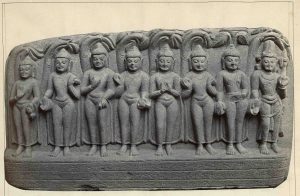
Bodhgayā (बोधगया) Chinese inscription (INCH0005) on a slab (OBCH0005) with the seven Buddhas (saptatathāgata 過去七仏) and Maitreya (弥勒仏). Edition here that of Bagchi and Ta-Fu (2011), see Concordance for bibliographic data. Working transcription (02/2021).
大漢國僧志義先發願勸三十萬人修上生行,施三十萬卷上生
經,自誦三十萬卷:如上功德,向回同生內陀。今至摩竭國,金
剛座,伏遇唯識座主歸寶與諸大德等同發願往生內陀。三十萬人
中,歸寶為第一人,志義第二,廣峰第三,下依?次第:惠嚴,
重達,全遵,緣真,義暹,惠秀,智永,奉升,清蘊等,並願親
奉彌勒慈尊。今結良緣,成此七佛已,為記之。
| Metadata | |
|---|---|
| Inscription ID | INCH0005 |
| Title | Bodhgaya Chinese inscription on a slab with the seven Buddhas and Maitreya |
| Alternative titles | Bodhgayā Chinese inscription on a slab with the seven Buddhas (saptatathāgata 過去七仏) and Maitreya (弥勒仏). |
| Parent Object | OBCH0005 |
| Related Inscriptions | INCH0004 |
| Responsibility | |
| Author | Chau Ta-fu |
| Print edition recorded by | Michael WILLIS |
| Source encoded | |
| Digitally edited by | Michael WILLIS |
| Edition improved by | |
| Authority for | Prabodh Chandra Bagchi with Chau Ta-fu, New Lights on the Chinese Inscriptions of Bodhgayā, pp. 101-104 in India and China: Interactions through Buddhism and Diplomacy: A Collection of Essays by Professor Prabodh Chandra Bagchi, edited by B. Wang and Tansen Sen (Delhi: Anthem Press, 2011). |
| Metadata recorded by | Michael WILLIS |
| Authority for metadata | Émmanuel-Édouard Chavannes, Les inscriptions Chinoises de Bodh-Gayâ, Revue de l'histoire des religions 34 (1896): 1-58. |
| Metadata improved by | Serena Biondo |
| Authoriy for improved | Prabodh Chandra Bagchi with Chau Ta-fu, New Lights on the Chinese Inscriptions of Bodhgayā, pp. 101-104 in India and China: Interactions through Buddhism and Diplomacy: A Collection of Essays by Professor Prabodh Chandra Bagchi, edited by B. Wang and Tansen Sen (Delhi: Anthem Press, 2011). |
| Language | 漢語 |
| Reigning monarch | Not recorded |
| Commissioner | Kui-pao |
| Topic | Registers the taking of a vow by visiting Chinese monks for attainment of the Tuṣitā heaven, and the carving of the seven Buddhas and Maitreya on the slab on which the vow was recorded. |
| Date: | |
| Min | 900 |
| Max | 1100 |
| Comment | The term great Han (大漢國) has drawn commentarial attention. Chavannes (1896): 3 sought to associate it with the Later Han (Five Dynasties) (947–951), a state in the Five Dynasties and Ten Kingdoms period; Bagchi and Ta-Fu (2011) provide a more precise date on the basis of their identification of one of the monks in written sources. |
| Hand | |
| Letter size | |
| Description | Layout not recorded |
| Layout | |
| Campus: | |
| Width | |
| Height | |
| Description | Layout not recorded |
| Decoration | |
| Bibliography | |
| References | Most recent reading in: Prabodh Chandra Bagchi and Chau Ta-fu, New Lights on the Chinese Inscriptions of Bodhgayā, pp. 101-02 In India and China: Interactions through Buddhism and Diplomacy: A Collection of Essays by Professor Prabodh Chandra Bagchi (Delhi: Anthem, 2011). |
| Add to bibliography | |
| Misc notes | Beal (1881): 554 states: “The forms of the characters may possibly be as ancient as the Han dynasty. But as the inscription has nothing to do with the figures of the seven mortal Buddhas, and the Bodhisatwa Maitreya sculptured above it, it is possible that the figures may have been executed after the inscription was placed in situ, and possibly much of the inscription itself erased.” This assessment cannot be accepted in the light of the most recent reading. This shows that the inscription refers specifically to the figures above. The date of the sculpture is therefore a key factor with regard to the date of the record. Cunningham (1892): 74 was of the view that the sculpture cannot be older than CE 1000 (see Concordance). In terms of style, the sculpture suggests a date around CE 1100. |